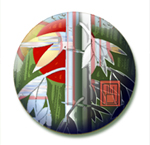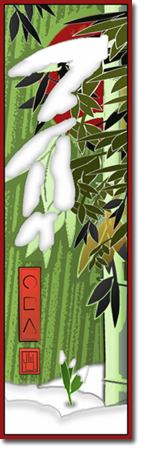On The Way: The Daily Zen Journal
Treatise on Sitting Meditation Part 2
Daikaku (1213-1279)
It takes incalculable eons to attain buddhahood by accumulating virtue and good qualities, but if you practice the way of unity of cause and effect, you realize buddhahood in one lifetime. Someone who illumines the mind and awakens to real nature sees that they are originally Buddha, not now attaining buddhahood for the first time.
Question: “Do those who realize Buddhahood by seeing reality not depend on cause and effect? Should they not cultivate virtue?
Although those who realize buddhahood by seeing their true nature may cultivate virtue, they do it for others’ benefit, not for rewards. Because they teach and transform sentient beings, they teach cause and effect; because they know they have no personal gain, they do not depend on merit—they have no mind at all.
Question: “What is no mind? If there is no mind at all, who sees reality; who awakens to the way? And who can expound the way to teach?”

No mind means that there is no deluded, foolish mind; it does not mean there is no mind to discern false from true. If one doesn’t think of sentient beings, doesn’t long for Buddhas either, doesn’t think of illusion or seek enlightenment, doesn’t go along with the honor of others, does not hope for fame, profit, support, or reputation, does not shrink from attacks from those who are resentful or hostile, and does not add any discriminating thoughts about any good or evil, one is called a mindless wayfarer.
Thus it is said, “The path is mindless of union with anyone, a mindless person unites with the way.”
Question: “Are there differences of more or less merit in fasting, observing the precepts, reading and reciting scriptures, spells, and chanting Buddha names?”
Eating once a day removes greed for food and results in great blessings and virtue in the coming life. Morality and discipline help to stop bad states of mind and produce a good mental state; those with good minds live in human and heavenly realms, in the highest states.
Since those who read the scriptures protect and maintain the teachings of the enlightened ones, these people will have great knowledge and wisdom in the coming life. No mind is the Buddha mind; the qualities of this enlightened mind cannot be reached by words or thoughts—it is truly inconceivable.
Question: “Such roots of goodness as these each have their merit, undoubtedly, but what is the virtue of mindlessness?”
Learning the standards of conduct of the Buddha, transmitting the sayings of the Buddha, and extolling the names of the Buddha have merit, so mindless wayfarers must also have merit; if you say no mind has no merit, then other practices cannot have any merit either.
All roots of virtue and good qualities are conditional, whether they be heavenly or humanly mundane; no mind is immediate witness of the path of enlightenment, so its merit cannot be adequately expressed in words—really it is the condition of the one great matter; the afflictions of birth and death die away of themselves, mind and body are one thusness—this is what it is.
How can there be any doubt about the immediate mind realizing buddhahood? That is why someone in ancient times said, “To make offerings to the Buddhas of the three times cannot compare to making offerings to one mindless wayfarer.” Actually this is the sphere which only an enlightened one can communicate to an enlightened one; ordinary people, disciples, and self-enlightened ones cannot fathom it.
Question: “The scriptures do not speak of no mind, nor do they praise it; by what school of teaching do you esteem this?”
Various scriptures have not failed to speak of it; some say “the path of words end,” some say “it cannot be explained,” or “ultimate emptiness,” or “the condition of the one great matter.” And also they say that all things are quiescent and dead—Shakyamuni shut his room, Vimalakirti closed his mouth. Does this not point to no mind?
Because the phantomlike bodhisattvas already have experiential knowledge of this, the Buddha does not preach it to them, and he does not teach it to seekers of sainthood and self-enlightenment because they could hardly attain it. That is why it says in the Lotus of Reality scripture, “Do not expound this scripture in the presence of ignorant people.” That’s what this means.
Although there are eighty four thousand entrances to the truth in the teachings, they do not go beyond matter and emptiness. They can’t explain the sphere of no mind, so they don’t extol this matter. Because words cannot reach it, it is called the special transmission outside the doctrine.
Question: “Is this body then to be considered illusion? Can it be considered enlightenment? And what is the mind? The basis of illusion and enlightenment should be known. And is the mind inside the body or outside the body? Where does it come from?”
The body of four gross elements (fire, water, earth, air) and five clusters (matter, sensation, perception, coordination, consciousness) fills the universe; all sentient beings are the foundation. Causes and conditions interact to form physical bodies—this is called birth.
When the results of the causes and conditions change and die out, then the four elements disperse—this is called death. In form and characteristics there are ordinary people and saints; in the essence of mind there is no delusion or enlightenment.
Even so, we provisionally define the deluded as sentient beings and the enlightened as buddhas. Delusion and enlightenment just depend on the deceiving mind—in the real mind there is no illusion or enlightenment. Sentient beings and buddhas are basically deluded or enlightened on the basis of one mind; when you comprehend its true nature, then ultimately there is no distinction between ordinary people and saints. Therefore the Surangama Sutra says: “The perfect illumination of inconceivable realty is beyond names and symbols; there is no original world or sentient beings.”
Daikaku (1213-1279)
Excerpted from The Original Face: An Anthology of Rinzai Zen trans by Thomas Cleary 1978




Oftentimes listening to someone else’s questions our own are addressed.
“What is no mind? If there is no mind at all, who sees reality; who awakens to the way? And who can expound the way to teach?”
The response is down to earth and understandable for any of us. To stay on track and not get overwhelmed by the illusions that surround us involves a lifetime of commitment. These are challenging times we inhabit, and the sheer volume of sights and sounds can exhaust our senses. The quest to seek out why we are here, what is really going on around us is one which requires constancy and dedication to carve out time each day to return to a place of pause, our practice. Whatever your own practice is, no matter what school or teacher you study with, it’s imperative to spend enough time with the tools that they become your own. Then we have a touchstone to carry within us, not dependent on a cushion or a sesshin to return, but one we can access anytime and in any activity.
Quietly so,
Elana